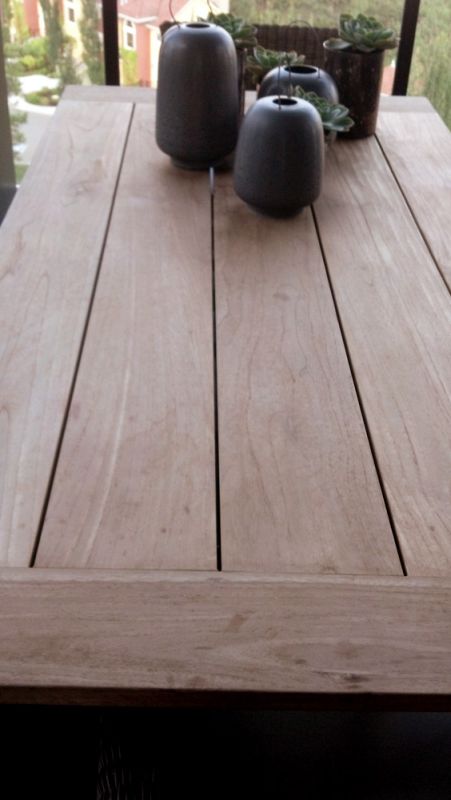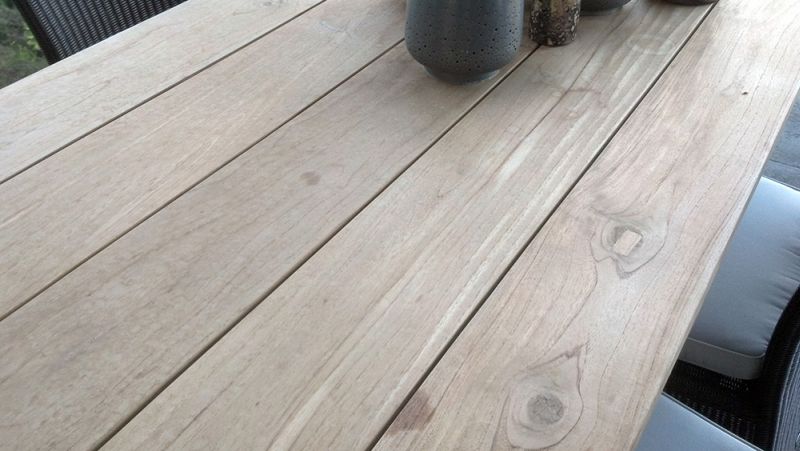Refinishing Teak Outdoor Furniture
The table in question might not even be Teak. But here are some thoughts about the choices for a natural-looking refinishing job. January 28, 2013
Question
I have a unique problem. A customer of mine has an unfinished solid teak patio table that, while very nice looking, isn't holding up to regular use due to spills/grease etc. getting on the table and leaving permanent marks. They want me to sand it down and apply some sort of protective finish, but don't want it to look like it's been finished (they don't want the color to change or for there to be visible film build). I have no idea what to apply to this table that wouldn't change the color. Are there any oil or wiping finishes anyone has used for this kind of thing with success?
Forum Responses
(Finishing Forum)
From contributor P:
It sounds like they are looking for something that doesn't exist.
From contributor F:
If you sand the teak down to get rid of the grease and whatever, the wood will be a nice rich brown. That could be oiled they actually make something called teak oil. However if your client wants to have the weathered grey look (minus the grease) you can stain it with any colored deck stain. SW makes them as well as a lot of other companies. If you sand it down to the brown then apply the teak oil, after about six months it will be that weathered grey. The downside is both items I mentioned have to be re-applied yearly.
From contributor R:
Look, if the customer wants grayed teak, don't finish it. Weathered teak is dry and has a checked surface. If you add oil it will age eventually, but much slower. Personally, I like teak that is not aged and that has a pretty teak color. As someone that has many years of finishing teak on yachts, varnish, or oil-varnish finishes are what I prefer since it is gorgeous wood with prominent grain character. There are some washes that can accelerate the graying process, I would suggest those. In New England there are washes that are used to gray newly cedar clad Cape Cods. I'd start there if still serious.
From the original questioner:
I should have specified that it was a white teak table - not greyed. I don't think they'd want it greyed, just the natural white teak color. It sounds from the responses there isn't really anything I can do to it other than sand it down for them - which is kind of what I figured to begin with. I considered some kind of water white sealer, but even that would probably change the color and I don't know that it would hold up any better than just leaving the wood raw. I guess Iíll just recommend a good sanding once per year!
From contributor K:
Are you sure it is teak? Teak is not white, at least not in its natural state. It is either a deep brown (sometimes golden) olive color or gray (after it's weathered).
From contributor R:
Contributor K is correct. Teak is not white. Also, teak is not smooth if it is weathered. If you sand it, it will be back to natural and not white or gray.
From the original questioner:
Thanks again. I did not realize there was no such thing as white teak. All the teak Iíve seen has been brown, but this top looks exactly like teak, only itís the color of birch (a creamy white color). I wonder what kind of wood it could be - any guesses? Here are photos of the table in question. If this is not teak, then what is it?

Click here for higher quality, full size image
http://www.woodweb.com/images_forums_public/finishing/table2.jpg

Click here for higher quality, full size image
From contributor I:
It could be plantation grown teak, but if it is it looks like it has been bleached. Whatever it is it looks like it has been bleached to remove color.
From the original questioner:
I read up on it and the wood does seem to resemble Goomar teak, though that wood has an orange hue (could have been bleached in this case). This client picks up stuff from all over and had all their cabs made custom locally with domestic (Canada) lumber. I know for a fact she keeps plenty of local custom shops very busy.

